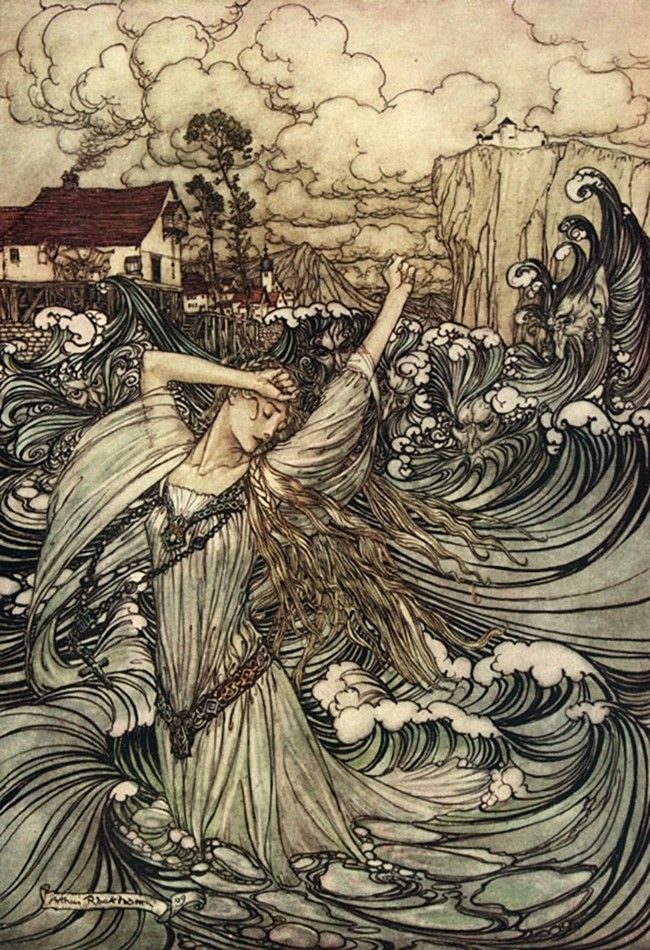
Ondines or Undines is the modern English term for Water elementals, spirits, or nymphs. The term is derived from the Latin term “Unda,” meaning “a wave.” Undines are seen as the true essence or spirit manifestation of waves in water. It is believed to first have derived from the Greek alchemical works of Paracelsus as the elemental spirits of water. It also is descriptive in some meanings and works for the focus of attention for water magic, whose course and function the undines control. They are believed to exist within the waters themselves and are not usually able to be seen with normal human vision unless the human has an artifact, charm, or spell to allow them to see faerie folk or unless blessed by the undine to be revealed.
Some believe that they live in the coral caves along lakes or on the banks of rivers. Smaller Victorian imagery of the undines depicts them living under lily pads. When seen, they resemble human beings, except for those of Victorian description living in smaller streams and ponds, fit more with the “Disney”-Esque Tinker Bell humanoid forms. Their clothing is usually described as being shimmery and green in color though reflective of all the shades and colors found in water.
Undines are also centered in European folklore as a type of water nymphs that become human when they fall in love with a human male and are doomed to die if he is unfaithful to her. Her essence is believed to have come from the Nereids, the attendants of Poseidon, the Sea god. Paracelsus first wrote about them, calling them spirits who inhabit the element of water. They are believed to dwell within every body of water in existence from streams, ponds, rocky pools, marshes, rivers, lakes, rivers, and ocean waves. Every waterfall, fountain, or well is believed to have an undine living within its waters. These also describe the Naiad, a female water nymph or spirit that guards over wells, springs, streams, brooks, fountains, and freshwater pools or lakes.
Some say the Undine is the saltwater variant, while the Naiad is the freshwater variant. Sometimes they are confused with Mermaids and Mermen. They are also sometimes confused or entwined with Oceanids. Most mythology places Undines in saltwater environments like the Oceanids and these creatures overlap and combine in folk tales around the world as either Nereids, Mermaids, Oceanids, Naiads, Undines, Ondines, or Water Nymphs. Some say they have interbred and there exists combinations, half-breeds, and mutations of these in watery realms. Since the Greeks thought of all the world’s waters as one biological system (bloodstream and veins of Gaia, the Earth mother – Gaia Hypothesis) that percolates in from the sea through the cavernous aquifers within the earth, the waters would mix and inter-lap.
They explain this in tales of such nymphs like Arethusa, the spring nymph, who could make her way from her spring through the subterranean flows from Peloponnesus to the surface on the island of Sicily. It is through this manner that Undines and Naiads often get confused. They became objects of local water cults and worshiped in various ways with requests for healing, blessings, magic, or passage. Sometimes people would offer them pins, charms, cloth, clouties, flowers, plants, or ritually drowned animals into their waters. In hopes that they might communicate prophecy, oracles were situated by ancient springs or wells. As they were seen to be a jealous lot, they could endanger seamen, explorers, or boats passing within their realms.
Related to Naiads.
Written, researched, and Copyrighted (© 2013) by Leaf McGowan, Thomas Baurley, Techno Tink Media
Bibliography, References, and Recommended Reading:
- Burkert, Walter 1985 “Greek Religion”. Harvard University Press.
- Graves, Robert 1955 “The Greek Myths”.
- Homer “Odyssey” and “Iliad”
- Poe, Edgar Allen 1829 “Sonnet to Science”.
- Silver, Carole B. Silver “Strange and Secret Peoples: Fairies and Victorian Consciousness”. ISBN 0-19-512199-6.
- Wikipedia: The Free Encyclopedia. undated “Naiads”, “Undines”. Web site referenced on March 8, 2014.
